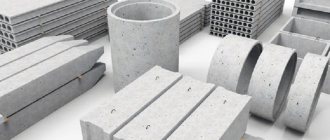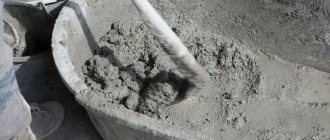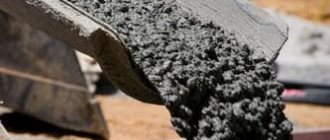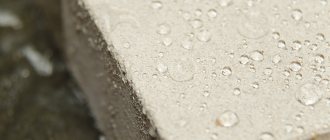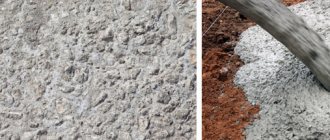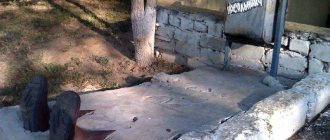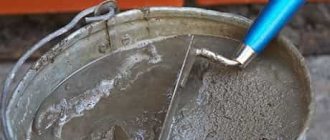Concrete is one of the most durable and strong materials, but its usual characteristics do not always correspond to construction conditions and the requirements for some structures. To obtain the desired properties, special additives are used in concrete, which are various chemical compounds. With their help, it is possible to solve such problems as carrying out concrete work at subzero temperatures, imparting high plasticity to the concrete mixture, increasing the strength of finished structures and their resistance to atmospheric influences.
Thanks to special additives, it has become possible to carry out concrete work in winter Source caretta.org
In what cases are supplements needed?
Depending on the location and operating conditions, concrete structures must meet certain requirements. Some are designed to withstand enormous loads, others – not to collapse from constant contact with water, others – to be resistant to abrasion, etc. Concrete additives help give them the desired properties. They are used in a variety of cases:
- during the construction of monolithic structures;
- when installing floors and coverings with high load-bearing capacity;
- when creating thin-walled or densely reinforced structures;
- during the construction of hydraulic structures;
- in the manufacture of such small-piece products as wall and facing blocks, paving slabs, paving stones, curbs;
- when carrying out work at sub-zero temperatures or in extreme heat.
Paving slabs must withstand mechanical and temperature loads, be resistant to abrasion and water. Source wixstatic.com
In addition, additives to concrete to increase strength, workability or mobility are used to prepare repair and plastering mortars, mortars based on porous or non-standard aggregates.
Nanoconcrete
Possibilities of nanoconcrete
Nanomodified concrete is one of the latest and very interesting developments in the construction industry. There is a large and very informative article about this material on our website, be sure to read it.
Now we will only say that this material has unique properties, which are achieved by introducing modified basalt microfiber and SSGG (special mixtures of ready-made additives) into ordinary concrete. You can hardly find them on the open market.
So, we have sorted out all types of concrete modifiers. You can find most of them in stores and use them when preparing mixtures with your own hands. The video in this article will complement our story.
Classification of additives
Among the additives produced, there are both products that affect the change of only one or two properties of concrete, as well as complex multifunctional additives. There are several main groups.
- Plasticizing agents – improve the mobility and plasticity of concrete mortar, reduce the amount of cement required for its preparation, and reduce the risk of shrinkage cracks.
- Accelerating hardening - this additive is used in concrete to increase strength and reduce the time required to build it.
- Water-reducing - allow you to reduce the amount of water for preparing the concrete mixture and provide it with increased density and frost resistance.
- Antifreeze - maintains normal reactions in the concrete solution necessary for hardening at sub-zero temperatures.
- Regulating mobility - maintain the fluidity and plasticity of concrete during long-term transportation or laying in hot weather.
When transported over long distances, concrete should not lose its properties Source ru-beton.ru
- Modifying - affecting several characteristics at once.
What are they used for?
Various additives are added to concrete to improve its properties.
When a concrete mixture is mixed between its fillers, binder and water, hydration occurs - a chemical reaction during which water breaks down into molecules, crystals form and the concrete hardens. The more fillers contained in the composition, the greater the number of irreversible reactions that will occur at different times. To regulate the rate of hydration, substances are added to the mixture, with the help of which the structure of concrete can be changed.
Additives promote various processes:
- decrease in pour point;
- increased fluidity;
- increasing adhesive properties;
- reducing the volume of concrete and its consumption;
- prevention of crack formation;
- increased water-repellent properties;
- narrowing of pores, etc.
In addition, concrete additives are used to obtain building materials with the required characteristics. Almost all components are based on chemical compounds and are produced in dry and liquid forms.
Characteristics and use of various additives
To decide what to add to concrete for strength, hydrophobicity or accelerated hardening, you need to understand the variety of additives.
Plasticizers
The purpose of using plasticizing additives is to improve the spreadability and mobility of a fresh solution by thinning the mixture without increasing the volume of water. Additional advantages are increasing the density, strength and uniformity of concrete, obtaining a high-quality smooth surface, and reducing labor costs when pouring.
In stores you can find such concrete additives called “Plasticizer” and “Superplasticizer”. The use of superplasticizers makes it possible to obtain mixtures with higher mobility and flow rates that are 6-7 times higher than usual. Substances for intensive strength gain are often introduced into their composition.
Superplasticizer for concrete Source virashop.ru
It is important! Plasticizing additives are introduced into the concrete mixture in strict accordance with the recommended dosages to prevent the solution from slipping.
The use of such additives is relevant for the manufacture of:
- monolithic densely reinforced structures;
- concrete industrial coatings and screeds with high loads;
- reinforced concrete products - wall panels, floor slabs, etc.;
- piece products made of sand concrete;
- repair and masonry mortars.
See also: Catalog of companies that specialize in repairing foundations of any complexity
Hardening accelerators
Often, to reduce construction time, you have to decide how to increase the strength of concrete without waiting for the standard 28 days to continue work. It is known that ordinary concrete gains grade strength during this period, during which it cannot be loaded. Such long technological pauses in work are not beneficial for either customers or contractors.
The need to reduce the hardening rate arises when pouring screeds, foundations, monolithic walls and ceilings, manufacturing paving slabs and cinder blocks, bricklaying with cement mortar and in many other cases.
Accelerators in the form of powder and aqueous solution Source beton-house.com
The effect of this strength additive in concrete is to activate the chemical reactions of cement hydration. Its introduction allows:
- increase the primary (stripping) strength of concrete by 20-40%;
- increase its brand strength by 10-20%;
- increase the mobility of the mixture;
- extend the service life of concrete structures.
Some additives in this group reduce the time required to gain brand strength to 7-10 days, allowing construction and installation work to continue much earlier than in a normal situation.
Other methods of strengthening concrete
Concrete can be strengthened not only with the help of additives that are used at the stage of mixing the solution. It happens that a structure needs to be strengthened after it is ready or several years after the start of operation. Liquid and solid hardeners are used for this purpose.
Strengthening impregnations
Liquid hardeners are made on the basis of water-soluble inorganic compounds. They penetrate concrete to a depth of 3–5 mm and react with it to form stronger compounds. Such impregnations can be applied to any structures that have not been treated with water repellents.
Dry hardeners
Typically, dry strengthening additives are prepared on the basis of cement. They are capable of increasing the strength of concrete up to 70 MPa, seriously increasing its ability to withstand tension, and optimizing wear resistance. Powdered substances are diluted with water and coated with them on structures, and the service life of the latter increases by 10–15 years.
Video description
Watch a video testing paving slabs made with and without a hydrophobic additive:
Other Supplements
Additives to cement can have other purposes, have a special or complex effect.
- Anti-corrosion additives give concrete resistance to acids and poorly soluble compounds, protect reinforcement and elements of removable and permanent formwork, and other metal structural elements in contact with concrete from rusting.
- Additives that improve the self-compaction of concrete make it possible to create thin-walled products and structures with a large number of reinforcing elements.
- Air-entraining additives slow down the evaporation of moisture from molding products, stimulating complete hydration of the cement.
- Multifunctional chemical additives for concrete have a complex effect and improve several of its characteristics at once.
Complex waterproofing additive Source promindex.ru
Anti-corrosion
The principle of operation is based on binding free calcium hydroxide, preventing it from reacting with the environment.
In this way, a gain in concrete service life is achieved. In addition, it becomes denser and its water-repellent properties increase.
There are also complex additives that give the solution beneficial properties from two or more classes at once. It is better to use just such additives, because the effect of mixing two or more separate additives is unpredictable - the ingredients may be incompatible.
How to change the properties of concrete using improvised means
People have always thought about improving the strength and durability of hardening building mixtures. There is information that in the old days masonry and plaster mortars were mixed using chicken eggs, which made them more dense, flexible and durable. It is difficult to say whether this is true, and it is unlikely that modern developers will incur such expenses.
However, many craftsmen believe that household detergents, rather than special chemicals, can be added to cement for strength and ductility. Less expenses, but the same result. Dishwashing detergents, liquid soap or washing powder dissolved in water are used as household plasticizers.
Fairy is the most popular home plasticizer Source setam.net.ua
Everyone knows that salt prevents water from freezing. And they apply this knowledge when mixing concrete in winter, increasing its frost resistance with the help of ordinary table salt. The main thing here is not to overdo it and not to add more than 2% of the volume of the dry mixture.
Briefly about the main thing
Concrete can have different characteristics depending on the brand of cement, the proportions of its components, the correct preparation, and the maturing conditions. These characteristics can be changed at your discretion, if you know that there are special additives for concrete: for strength, for increasing ductility and hardening speed, for resistance to water and low temperatures. The introduction of a small amount of these substances into the solution makes it possible to simplify concrete work and increase the durability of buildings, structures and concrete products.
Varieties
There are various antifreeze additives, each of which has its own mechanism of action. A popular additive is sodium carbonate, otherwise called potash. This is a powdery crystalline composition that accelerates the hardening of the concrete mixture. The use of an additive of this type reduces the technical characteristics of the material, including strength. To reduce this effect, sodium tetraborate is added to potash.
Attention! Potash is classified as a hazardous substance, therefore safety requirements are observed when working with it.
Sodium tetraborate is a complex substance consisting of sodium and calcium salts with the addition of ammonium. This is an additional antifreeze additive used with sodium carbonate. Without it, the structure can lose up to 30% of its strength after thawing and complete hardening.
Sodium nitrite is an effective antifreeze additive that reduces the crystallization temperature of water, accelerates the hardening of the composition, and has an anti-corrosion effect. Its use is dangerous, since sodium nitrite powder is a flammable, explosive, toxic substance. Used in frosts down to -25ºС. It cannot be mixed with lignosulfonic acids, since it releases toxic gas when interacting with them. Calcium nitrite has similar properties.
Sodium formate is an antifreeze additive for concrete, reducing the crystallization temperature of water and accelerating the hydration of cement. It is added in a proportion of no more than 6% of the total mass of concrete. To improve plasticization, naphthalene lignosulfonate is added to the additive.
Urea is a PMD, prolongs the liquid phase of water, and has virtually no effect on the setting speed.
Calcium and sodium chlorides, ammonia water reduce the freezing point, but have an increased corrosive effect. They have a strong effect on metal elements and are therefore not recommended for use in reinforced concrete products.
